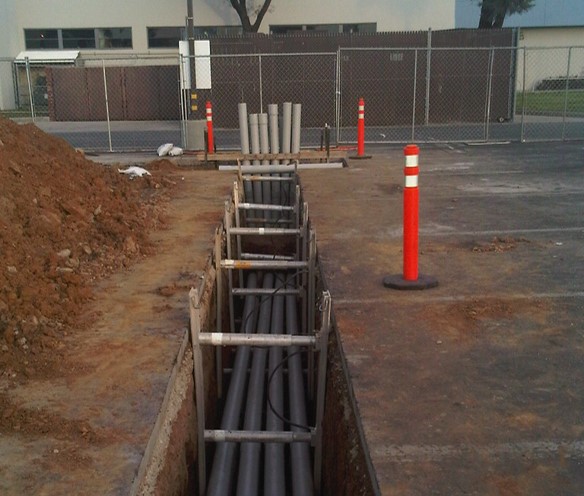Designing the Depths of Power: Underground Transmission
Written by Siraj Dalaq, PE, Senior Transmission Engineer, and Suhaib Alasmar, Transmission Engineer
What is Underground Transmission?
Underground transmission in power delivery is the process of transferring electrical power using cables that are buried below the surface. Unlike visible overhead transmission lines connecting across poles, underground cables are hidden from view; this offers different benefits and design challenges.
You'll often find underground transmission systems weaving through crowded urban landscapes, delicate ecosystems, or areas where the local scenery is too beautiful to disrupt. They are the go-to choice in regions with strict regulations or insufficient space for overhead transmission infrastructure.

Designing an Underground Transmission System
Designing an underground transmission system requires careful planning and precise calculations. Engineers must follow safety requirements and best practices while incorporating the right software and key components into the design.
Specialized Software
To meet design requirements, engineers can utilize this specialized software to help:
- CYMCAP 8.0: Size cables correctly, ensuring they operate within safe thermal limits.
- Pull Planner 4.0: Calculate the pulling tension on cables during installation.
- BoreAid: Assist with horizontal directional drilling (HDD) calculations.
- AutoCAD Civil 3D: Create detailed planning and profiling.
Thermal Impacts
When designing an underground system, engineers must consider several thermal factors:
- Cable Sizing and Design Adjustments: Ensuring effective heat dissipation.
- Soil Characteristics: The soil's properties can affect cable heat dispersing.
- Mutual Heating Effects: Cables close together can heat each other up.
- Duct Bank Concrete and Backfill: Protection and thermal dissipation for underground cable systems.
Key Components
The underground transmission network is made up of several critical parts:
- High Voltage Power Cables: The lifelines that carry electricity.
- Cable Splicing: Joining cables together to extend their reach.
- Cable Racking Design: Ensuring cables are organized and secure.
- Link Box: Grounding cable sheaths and offering surge protection.
- Terminations: The endpoints where cables connect to other equipment.
- Conduits: Protective ducts for the cables.
- Duct Banks: Concrete structures that house and protect cables.
- Transition Structures: Where cables shift from underground to overhead.
- Splice Vaults or Manholes: Access points for maintenance and cable splicing.
- Trenchless Methods: Installing cables without digging long trenches.
- Distributed Temperature System (DTS): Monitoring cable temperatures.
- Fiber Communication: Integrating communication lines with power cables.
Choosing Underground Transmission
Underground transmission is a sophisticated and reliable way to deliver power where overhead lines aren't suitable. Despite its higher initial costs and complex design requirements, it is an overall beneficial investment in safety, aesthetics, and environmental preservation. As our cities grow and our landscapes need protection, underground transmission will play an increasingly vital role in powering our world.
We offer comprehensive services for underground transmission design, including EMF studies, conductor sizing, ampacity and pulling calculations, duct bank design, riser pole design, fiber layout, DTS design, cable procurement support, manhole design, and grounding layout. Our team will partner with you to support the design of your next underground transmission system. Contact our underground transmission team today.